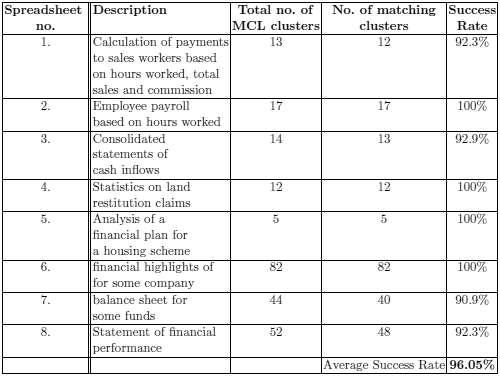Authors
Bennett Kankuzi & Yirsaw Ayalew
Abstract
Spreadsheets are computer programs. However, as with programs written in traditional programming languages, it is very difficult to understand a spreadsheet created by others.
This is because spreadsheet users normally view the superficial numerical (value) view of spreadsheets although computations are specified through “hidden” cell formulas. The cell formulas also define the data-flow structure of the spreadsheet.
In this paper, we present a technique that highlights logical areas in spreadsheets which may act as a guide in understanding a spreadsheet. Instead of focussing their attention on the whole spreadsheet, spreadsheet users may narrow their focus to one logical area at a time.
We identify logical areas in spreadsheets by using the MCL (Markov Clustering) algorithm on the underlying spreadsheet data-flow graph.
Sample

The average success rate of the MCL algorithm on the eight spreadsheets used in the experiment is 96.05%.
Success means that the MCL clusters produced matched with what we perceived to be logical areas.
Based on the results of this experiment with success rate as a performance measure, we conclude that the MCL algorithm performs satisfactorily.
Publication
2008, 20th Annual Conference of the Psychology of Programming Interest Group, September, Pages 4-14
Full article
An MCL algorithm based technique for comprehending spreadsheets
